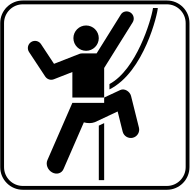 Some of you may wonder what determines the grade or difficulty of a route. Here are some useful resources:
Some of you may wonder what determines the grade or difficulty of a route. Here are some useful resources:
Alpine Climbing (NCCS)
| Grade I: | Normally requires several hours; can be of any difficulty. |
| Grade II: | Requires half a day; any technical difficulty |
| Grade III: | Requires a day to do the technical portion; any technical difficulty |
| Grade IV: | Requires a full day for the technical portion; the hardest pitch is usually no less than 5.7 (in the Yosemite Decimal System rating) |
| Grade V: | Requires a day and a half; the hardest pitch is usually 5.8 or harder |
| Grade VI: | A multiday excursion with difficult free climbing and/or aid climbing |
Free Climbing (YDS)
Class 1: Hiking
Class 2: Simple scrambling, with the possible occasional use of the hands
Class 3: Scrambling; a rope might be carried
Class 4: Simple climbing, often with exposure. A rope is often used. A fall on Class 4 rock could be fatal. Typically, natural protection can be easily found
Class 5: Where rock climbing begins in earnest. Climbing involves the use of a rope, belaying, and protection (natural or artificial) to protect the leader from a long fall. Fifth class is further defined by a decimal and letter system – in increasing and difficulty. The ratings from 5.10-5.15 are subdivided in a, b, c and d levels to more precisely define the difficulty (for example: 5.10a or 5.11d)
5.0-5.7: Easy for experienced climbers; where most novices begin.
5.8-5.9: Where most weekend climbers become comfortable; employs the specific skills of rock climbing, such as jamming, liebacks, and mantels.
5.10: A dedicated weekend climber might attain this level.
5.11-5.15: The realm of true experts; demands much training and natural ability and, often, repeated working of a route.
You can find more info here.
